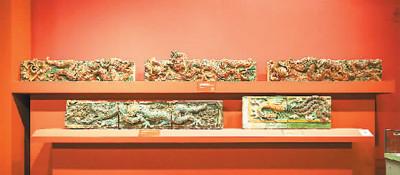
Glazed ridge ornaments on Qing Dynasty architecture. Courtesy of Shanxi Museum
Recently, the Shanxi Museum launched the exhibition "Jin Yun Huacai - Shanxi Glass Art", bringing together more than 300 pieces (groups) of Shanxi glass art works, showing the unique charm of traditional Chinese glass art.
Shanxi has been an important area for the production and use of glass since ancient times. Shanxi Liuli, widely used, orderly inheritance and many genres, is an excellent Chinese cultural heritage, which has been passed down for thousands of years and shines brightly.
The exhibition is divided into 3 units. The first unit, "Heaven and Earth Condensation Rhyme", sorts out the development process of early glass art. A large number of exquisite low-temperature glazed pottery pottery has been excavated from Han tombs throughout Shanxi; lead-glazed pottery can be seen in many important sites during the Northern Dynasty; during the Sui and Tang dynasties, sancai glazed pottery has achieved remarkable achievements; during the Two Song Dynasties, many fine glass works appeared in architecture and tombs.
The second unit, "Temple Charm", focuses on the production techniques and excellent works of Shanxi glass in the Yuan, Ming and Qing dynasties. The development and progress of glass technology in the Yuan Dynasty, the Yongle Palace created in the early Yuan Dynasty, the glass components on the roof of each hall tile are extremely skilled. In the Ming Dynasty, the citizens developed economically, the city prospered, temples were built, the scale and technology of glass production reached a new high, and the fine works of glass art were rich and colorful. In the Qing Dynasty, the glass manufacturing industry began to decline, the building components were formatted, and the plain ridges on the roof increased, but many craftsmen were hereditary and still left many excellent works.
The third unit, "Ancient Color New Rhyme", reflects the spirit of craftsmanship. The traditional glass making techniques of Shanxi have continued to this day, and many workshops for firing glass are still preserved in Yangcheng, Taiyuan, Hejin, Jiexiu and other places. The combination of the inheritance of traditional skills and the application of modern technology has made the ancient art of glass shine with the brilliance of the times.
It is reported that the exhibition will last until March 20. (Reporter Zou Yating)
People's Daily Overseas Edition ( 2022-01-18 Issue 07)
Source: People's Daily Overseas Edition